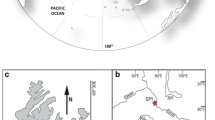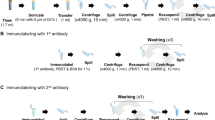Abstract
It is well known that there are prokaryotes small in size (e.g. ultra-microprokaryotes) that pass through a 0.2-μm filter. As bacterial and viral abundances are determined by epifluorescence microscopy and the differentiation between them is based on particle size, some bacteria can be erroneously enumerated as viruses, namely in marine waters where bacteria are small. However, there is no information on the proportion of prokaryotes that could be misidentified as viruses by epifluorescence microscopy. In this work, we assessed, in water samples collected in the estuarine system Ria de Aveiro (Portugal), the proportion of prokaryotes that could be counted as viruses by the current widespread epifluorescence microscopy and, for the first time, by fluorescence in situ hybridization (FISH). The total number of particles was determined on membranes of 0.2 and 0.02 μm after staining with 4′,6-diamidino-2-phenylindole (DAPI), and the number of prokaryotes (Bacteria and Archaea) was determined by FISH for both pore size membranes. The results show that, in the marine zone of the estuarine system, 28 % of particles enumerated as virus-like particles were prokaryotes, but, in the brackish water zone, only 13 % of the particles counted as viruses were actually prokaryotic cells. Epifluorescence microscopy overestimates viral abundance, and also the ratio viruses:prokaryotes, and this error must be taken into consideration because it can vary significantly within a system. In fact, in the marine zone of an estuarine system, the overestimation of viral abundance can be twice as high as in the brackish water zone.

Similar content being viewed by others
References
Ackermann HW (2007) 5500 Phages examined in the electron microscope. Arch Virol 152:227–243
Almeida M, Cunha M, Alcântara F (2002) Seasonal change in the proportion of bacterial and phytoplankton production along a salinity gradient in a shallow estuary. Hydrobiologia 475:251–262
Almeida M, Cunha MA, Alcantara F (2001) Loss of estuarine bacteria by viral infection and predation in microcosm conditions. Microb Ecol 42:562–571
Almeida MA, Alcantara F (1992) Bacterial colonization of seston particles in brackish waters (Ria de Aveiro, Portugal). Marine ecology progress series. Oldendorf 89:165–173
Amann R, Fuchs BM (2008) Single-cell identification in microbial communities by improved fluorescence in situ hybridization techniques. Nat Rev Microbiol 6:339–348
Amann R, Fuchs BM, Behrens S (2001) The identification of microorganisms by fluorescence in situ hybridisation. Curr Opin Biotechnol 12:231–236
Amann R, Snaidr J, Wagner M, Ludwig W, Schleifer K-H (1996) In situ visualization of high genetic diversity in a natural microbial community. J Bacteriol 178:3496–3500
Amann RI, Binder BJ, Olson RJ, Chisholm SW, Devereux R, Stahl DA (1990a) Combination of 16S rRNA-targeted oligonucleotide probes with flow cytometry for analyzing mixed microbial populations. Appl Environ Microb 56:1919–1925
Amann RI, Krumholz L, Stahl DA (1990b) Fluorescent-oligonucleotide probing of whole cells for determinative, phylogenetic, and environmental studies in microbiology. J Bacteriol 172:762–770
Azam L (1983) 1 The ecological role oi water-column microbes in. Mar Ecol Prog Ser 1:257–263
Baptista I, Santos AL, Cunha Â, Gomes NCM, Almeida A (2011) Bacterial biomass production in an estuarine system: high variability of leucine conversion factors and changes in bacterial community structure during incubation. Aquat Microb Ecol 62:299–310
Buesing N (2005) Bacterial counts and biomass determination by epifluorescence microscopy. In: Methods to study litter decomposition. Springer, Dordrecht, pp 203–208
Cho BC, Azam F (1990) Biogeochemical significance of bacterial biomass in the ocean’s euphotic zone. Mar Ecol Prog Ser 63:253–259
Danovaro R, Corinaldesi C (2003) Sunscreen products increase virus production through prophage induction in marine bacterioplankton. Microb Ecol 45:109–118
Ducklow HW, Carlson CA (1992) Oceanic bacterial production. Adv Microb Ecol 12:113–181
Eilers H, Pernthaler J, Glöckner FO, Amann R (2000) Culturability and in situ abundance of pelagic bacteria from the North Sea. Appl Environ Microb 66:3044–3051
Fischer UR, Velimirov B (2002) High control of bacterial production by viruses in a eutrophic oxbow lake. Aquat Microb Ecol 27:1–12
Hennes KP, Suttle CA (1995) Direct counts of viruses in natural waters and laboratory cultures by epifluorescence microscopy. Limnol Oceanogr 1050–1055
Holligan P, Williams PJB, Purdie D, Harris R (1984) Photosynthesis, respiration and nitrogen supply of plankton populations in stratified, frontal and tidally mixed shelf waters. Mar Ecol Prog Ser 17:201–213
Kemp P, Lee S, LaRoche J (1993) Estimating the growth rate of slowly growing marine bacteria from RNA content. Appl Environ Microbiol 59:2594–2601
Lopes JF, Almeida MA, Cunha MA (2010) Modelling the ecological patterns of a temperate lagoon in a very wet spring season. Ecol Model 221:2302–2322
Oliveira V, Santos AL, Aguiar C, Santos L, Salvador ÂC, Gomes N, Silva H, Rocha SM, Almeida A, Cunha  (2012) Prokaryotes in salt marsh sediments of Ria de Aveiro: effects of halophyte vegetation on abundance and diversity. Estuar Coast Shelf Sci 110:61–68
Pereira C, Salvador S, Arrojado C, Silva Y, Santos AL, Cunha A, Gomes N, Almeida A (2011) Evaluating seasonal dynamics of bacterial communities in marine fish aquaculture: a preliminary study before applying phage therapy. J Environ Monit 13:1053–1058
Pernthaler J, Glöckner F-O, Schönhuber W, Amann R (2001) Fluorescence in situ hybridization (FISH) with rRNA-targeted oligonucleotide probes. Methods Microbiol 30:207–226
Pomeroy L (1981) Status and needs in protozoan ecology. In: Reid PC, Turley CM, Burkhill PH (eds) Protozoa and their role in marine processes. NATO ASI Series G: Ecological Sciences, vol. 25. Springer, Heidelberg, pp 475–492
Riemann B, Søndergaard M (1986) Regulation of bacterial secondary production in two eutrophic lakes and in experimental enclosures. J Plankton Res 8:519–536
Sheridan G, Masters C, Shallcross J, Mackey B (1998) Detection of mRNA by Reverse Transcription-PCR as an Indicator of Viability in Escherichia coli Cells. Appl Environ Microbiol 64:1313–1318
Suttle CA (1994) The significance of viruses to mortality in aquatic microbial communities. Microb Ecol 28:237–243
Suttle CA (2000) Ecological, evolutionary, and geochemical consequences of viral infection of. Viral Ecol 247
Suttle CA (2007) Marine viruses—major players in the global ecosystem. Nat Rev Microbiol 5:801–812
Weinbauer MG (2006) Ecology of prokaryotic viruses. FEMS Microbiol Rev 28:127–181
Wommack KE, Colwell RR (2000) Virioplankton: viruses in aquatic ecosystems. Microbiol Mol Biol Rev 64:69–114
Acknowledgments
Thanks are due to the University of Aveiro and to the Centre for Environmental and Marine Studies (CESAM, project Pest-C/MAR/LA0017/2011) for funding the Research Group.
Competing interests
The authors declare that they have no competing interests.
Author information
Authors and Affiliations
Corresponding author
Rights and permissions
About this article
Cite this article
Mendes, C., Santos, L., Cunha, Â. et al. Proportion of prokaryotes enumerated as viruses by epifluorescence microscopy. Ann Microbiol 64, 773–778 (2014). https://doi.org/10.1007/s13213-013-0713-y
Received:
Accepted:
Published:
Issue Date:
DOI: https://doi.org/10.1007/s13213-013-0713-y




